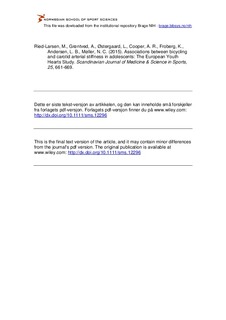| dc.contributor.author | Ried-Larsen, Mathias | |
| dc.contributor.author | Grøntved, A. | |
| dc.contributor.author | Østergaard, Lars | |
| dc.contributor.author | Cooper, Ashley R. | |
| dc.contributor.author | Froberg, Karsten | |
| dc.contributor.author | Andersen, Lars Bo | |
| dc.contributor.author | Møller, Niels C. | |
| dc.date.accessioned | 2016-05-25T09:38:01Z | |
| dc.date.available | 2016-05-25T09:38:01Z | |
| dc.date.issued | 2015-10 | |
| dc.identifier.citation | Scandinavian Journal of Medicine & Science in Sports. 2015, 25, 661-669 | nb_NO |
| dc.identifier.uri | http://hdl.handle.net/11250/2390308 | |
| dc.description | Dette er siste tekst-versjon av artikkelen, og den kan inneholde små forskjeller fra forlagets pdf-versjon. Forlagets pdf-versjon finner du på www.wiley.com: http://dx.doi.org/10.1111/sms.12296
This is the final text version of the article, and it may contain minor differences from the journal's pdf version. The original publication is available at www.wiley.com: http://dx.doi.org/10.1111/sms.12296 | nb_NO |
| dc.description.abstract | The aim of the study was to investigate the associations between bicycling and carotid arterial stiffness, independent of objectively measured moderate-and-vigorous physical activity. This cross-sectional study included 375 adolescents (age 15.7 ± 0.4 years) from the Danish site of the European Youth Heart Study. Total frequency of bicycle usage was assessed by self-report, and carotid arterial stiffness was assessed using B-mode ultrasound. After adjusting for pubertal status, body height, and objectively measured physical activity and other personal lifestyle and demographic factors, boys using their bicycle every day of the week displayed a higher carotid arterial compliance {standard beta 0.47 [95% confidence interval (CI) 0.07–0.87]} and distension [standard beta 0.38 (95% CI −0.04 to 0.81)]. Boys using their bicycle every day of the week furthermore displayed a lower Young's elastic modulus [standard beta −0.48 (95% CI −0.91 to −0.06)]. Similar trends were observed when investigating the association between commuter bicycling and carotid arterial stiffness. These associations were not observed in girls. Our observations suggest that increasing bicycling in adolescence may be beneficial to carotid arterial health among boys. | nb_NO |
| dc.language.iso | eng | nb_NO |
| dc.publisher | Wiley-Blackwell Publishing Inc. | nb_NO |
| dc.subject | physical activity | nb_NO |
| dc.subject | exercise | nb_NO |
| dc.subject | transportation | nb_NO |
| dc.subject | carotid stiffness | nb_NO |
| dc.subject | vascular health | nb_NO |
| dc.subject | Actigraph | nb_NO |
| dc.title | Associations between bicycling and carotid arterial stiffness in adolescents: the European Youth Hearts Study | nb_NO |
| dc.type | Journal article | nb_NO |
| dc.type | Peer reviewed | nb_NO |
| dc.subject.nsi | VDP::Social science: 200 | nb_NO |
| dc.subject.nsi | VDP::Social science: 200::Social science in sports: 330 | nb_NO |
| dc.subject.nsi | VDP::Social science: 200::Social science in sports: 330::Other subjects within physical education: 339 | nb_NO |
| dc.source.journal | Scandinavian Journal of Medicine & Science in Sports | nb_NO |
| dc.description.localcode | Seksjon for idrettsmedisinske fag / Department of Sport Medicine | nb_NO |
